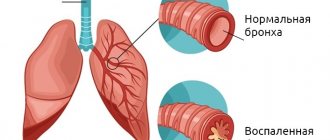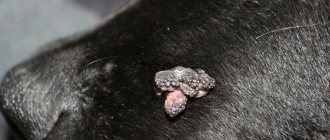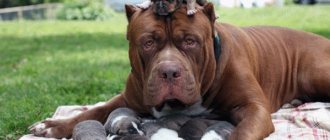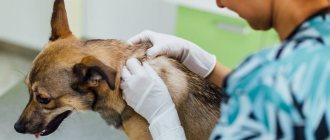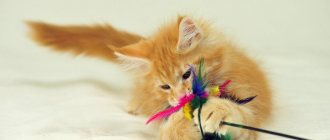What breed of dog is in the Cesar food commercial?
- West Highland White Terrier advertises CESAR commercial small dog food. With her appearance she attracts a large number of buyers of this food and attracts attention, and in fact the dog is lovely and her activity is also pleasing.
- Caesar food is advertised for a dog of the West Highland White Terrier breed. The dog is very beautiful and, like a real terrier, is very devoted to its owner and can always protect her. And what a devoted and loving look she has, it’s simply captivating. I immediately liked this advertisement thanks to the dog.
- The dog food advertisement featured a small dog with white fur and small, kind eyes. The breed is extremely loyal to humans; they are excellent loyal protectors. The name of the breed is: West Highland White Terrier.
- In an advertisement for Caesar food, there really is a cute little white dog running around with a smart look. And she also looks very devoted. Cutie. This dog belongs to the breed with the very long and clever name of the West Highland White Terrier. Like this, below is one of the representatives of this breed:
Very sweet.
- The cutest white dog from an advertisement for dog food quot; Caesarquot; belongs to the West Highland White Terrier breed. At first glance it may seem that this is a decorative dog, but this is not so. This breed was bred in Scotland for hunting. This is a hunting dog. By nature, dogs of this breed are lively, playful and very brave. If necessary, they can intercede and protect the owner.
- This dog was bred in Scotland and is not at all as harmless as in advertising - it is a hunter and hunts animals such as fox and badger. E size is not just for pampering at home, she was bred specially small to get prey out of holes. Well, this breed is called beautifully in Scottish:
- A very cute dog of the West Highland White Terrier breed. Such a cute dog can be a faithful friend for a child, but it requires special care. But the dog will thank you for this with its devotion and cheerful character. The dog looks like a big cat.
- In an advertisement for dog food quot; Caesarquot; we see a white, smart dog that is very active and devoted to its owner. These dogs really are like that. They love to interfere, especially love hunting, and are very devoted to their owners. This breed is called the West Highland White Terrier.
- The breed of the small white dog that is being filmed for the Caesar commercial is called the West Highland White Terrier. In appearance it is white and fluffy, but by nature it is very brave and will protect its owner in case of danger. Photo of the dog:
- The marketers, of course, have done well once again, because they have chosen an incredibly charming and cute breed of dog for food advertising, which looks less like a pet and more like a soft toy. The name of the breed, by the way, is also unusual in sound, I would even say fabulous, namely
>Characteristics of Dogo Argentino dogs with reviews and photos
4/5 (1)
History of the origin of the breed
The Dogo Argentino, or as the Argentines call it, the white angel of death, is a young, artificially bred breed. It appeared thanks to the young ambitious 18-year-old Argentinean Antonio Nores Martinez. He dreamed of breeding a new breed of dog that would help him become a great hunter.
Having read the relevant literature, he and his younger brother in 1925 began breeding a fast, brave, strong hunting dog that could easily get along in ordinary families.
The base breed was the now extinct Cordoba fighting dog (Perro Pelea de Cordobes), which was already a mixture of the muscular Spanish mastiff, as well as the broad-chested English bulldog and bull terrier. For further development of the breed the following were taken:
- the Dogue de Bordeaux, which made the dog even more powerful;
- a boxer who conveyed his poise;
- Irish Wolfhound, which added speed to the breed;
- an English pointer who endowed her with an impeccable keen sense of smell;
- Great Dane, which increased the dog's height;
- Great Pyrenees dog, firmly fixed in white.
Three years later, the first attempts were made to introduce a breed standard. But only after almost 30 years the breed was stabilized as much as possible. Unfortunately, Antonio did not live to see this moment. In 1954 he was killed while hunting.
Further work was continued by his younger brother Augustine. His diplomatic activities contributed to the fact that these dogs quickly began to gain popularity, first in Argentina, then abroad. He simply gave puppies to foreign ambassadors and diplomats, who took them to their homeland.
In 1964, the breed was approved by the Argentine Kennel Federation, and in 1973, the Dogo Argentino was officially recognized by the FCI. This breed is considered the only recognized dog breed in Argentina. The people of Argentina are so proud of these dogs that they consider them a national treasure and even immortalized them in a monument.
At the moment, in addition to its homeland, Argentine is confidently gaining popularity in many European countries. The breed achieved its greatest success in Italy, France, Germany and Holland.
Character of the Dogo Argentino breed
Harmoniously built, with prominent muscles, the dogs are endowed with a calm and balanced character. They are equally devoted to all family members, but they show special treatment to children. As a rule, these dogs are not prone to causeless aggression.
They are quite calm and friendly towards people. But, like other large breeds, they require early socialization, i.e. communication with the outside world. Other pets may be perceived as prey.
Argentinos love to interact with their owners. They do not single out one person, but faithfully and devotedly serve all members of their family.
However, from the very beginning it is necessary to firmly indicate what place the dog occupies in the family hierarchy, since a family for them is a pack. For the same reason, you should be careful when taking an adult, which is difficult to adapt to a new system of subordination.
Despite their strength and power, these dogs are very sensitive and vulnerable. They can hardly bear any insults from their owners and do not forget them for a long time. Dogs are not vindictive and are not prone to revenge. It will be quite difficult to regain the trust and affection of your pet. If you do not specifically instill anger, then this is a kind, patient and peace-loving breed.
It must be borne in mind that if the owner is in even the slightest danger, Argentines always make their own decisions. You may not even have time to notice how your defender will attack a potential threat. When constantly spending time in an enclosure or on a leash without human attention, dogs become aggressive and difficult to control.
Composition of Caesar feed
Let's look at the composition of a small bag called a pouch. They are most often found on store shelves in our country. For example, let's take a ready-made Caesar diet (beef and vegetables). Contains:
- meat - beef and offal (40%). The beef content should be more than half;
- vegetables - 4%;
- cereals - no percentage indicated;
- mineral and vitamin complex.
Note that the food contains almost 80 grams of moisture (per 100 grams). This means that the dog will not feel thirsty and there will be no problems with the gastrointestinal tract. Caesar food recipes are not very diverse; only the meat component changes.
How to choose a puppy
You need to adopt a puppy at three months of age. By this time, the babies will have fully grown stronger and will have adopted all the necessary initial skills from their mother. It is also at this age that some possible health and behavioral problems become visible.
When choosing a future pet, pay attention to the living conditions of the mother and puppies. This must be a clean and dry area. Puppies must be well-groomed and well-fed, but not overfed, with eyes free of discharge and clean ears. Check for irritation and rashes on exposed skin.
The Dogo Argentino is a dog with developed muscles, so puppies already at this age have the makings of a future athlete. This is primarily a working breed. After observing the behavior, choose an active, curious and strong baby.
Purebred puppies should be white or have one small spot around one eye. You should not purchase a puppy from dubious sellers who cannot confirm the purity of the breed. Any impurity can negatively affect the behavior and character of the dog.
It would be ideal to go to a special nursery, where they will help you choose a puppy for its intended purpose: for further breeding, a show class representative or a guard and companion for the family and home. This choice may determine how much a Dogo Argentino is worth.
The article was written by the team at Dogfriend Publishers. We are often asked about “canine translator” Cesar Millan. He is such a serious problem in the dog world that we cannot help but devote a separate article to him. Caesar Millan (Cesar Millan) began the conquest of America with an illegal crossing across the Mexican border. A hard life, a cherished dream and knowledge about dogs gained on my grandfather's farm. Today he is a TV star, a dog “psychologist” who has worked with Hollywood celebrities. His populist slogans (meeting and balancing all the dog's needs through "exercise, discipline and love"), snow-white smile and working methods fit so well into modern corporate culture that millions of people around the world overnight became his ardent fans. But behind the mantras about strengthening leadership there is outdated knowledge, and deft movements and spectacular poses - unjustified cruelty. Dominance, pack leader, leadership The owner must be a strong leader, pack leader, who dominates the dog. Lack of leadership leads to discipline problems and behavior problems in dogs. This is the attitude of dog trainers of the last century, which was based on observations of wolves and was transferred to the relationship between man and dog. This is an incorrect setting. Because:
- Myths about the connection between alpha status and aggression, rank order and dominance in wolves were dispelled many years ago. Contrary to the ideas of the past, a wolf pack is not torn apart by an endless struggle for the highest level of hierarchy and dominance; on the contrary, the pack is a peaceful family with a natural division of labor.
- Dogs are not wolves. This is a different biological species, with a different social structure and a different, closer relationship with humans. Neither in packs of stray dogs nor in domestic “packs” was it possible to find a rigid hierarchy. Dog aggression towards owners and other “behavior problems” have nothing to do with “dominance” or an attempt to occupy the highest level of the hierarchy. These are proven scientific facts.
A dog trainer or psychologist who still clings to long-debunked myths about dominant dogs is displaying the highest degree of ignorance and is at least a couple of decades behind the times. There is a huge hole in his education; he missed a whole layer of cynology (New Cynology), which makes harmonious communication and work with a dog possible - without violence, coercion and outdated theories. But “dominance theory” is the central point of Cesar Millan's program. Millan's insidious plans to seize power in the family are hatched by everyone: a harmless puppy, who, due to his age, simply did not have time to learn the rules of household etiquette, and hissing cats and dogs (which dominate even a laser pointer!)... Stupidity that has no boundaries : the priest had a dominant dog, he loved it... Cruelty Of course, Cesar Millan is harmful not because he accuses the dog of trying to dominate the laser pointer. His training methods are harmful and dangerous - this is violence, sometimes turning into real torture: intimidation (threatening macho poses with a gaze into the eyes of an unfamiliar dog), heel strikes in the stomach, kicks in the genitals, jerking the leash, tying up, grabbing the withers , "alpha coup", strict collars, nooses. A branch of the Holy Inquisition on the National Geographic Channel? (Excerpts from Millan's programs are regularly deleted or access to them is limited. We cannot keep all videos up to date) This is a particularly brutal reprisal. Millan interprets symptoms of severe stress (helpless appearance, narrowed eyes, erection) as a “state of dominance.” The blue tongue of an exhausted Malamute is a sign of asphyxia (or simply suffocation). Such torture often results in serious physical injuries (for example, damage to the esophagus, hyoid bone, spine), which can provoke further health problems (especially with the musculoskeletal system) and behavioral problems (for example, nervousness caused by pain or thyroid dysfunction, timidity, etc.). Also, what kind of psychological trauma has this dog suffered? Will she be able to trust people after this torture? What person, dog or even object from the scene of the massacre will be imprinted in her memory and will be associated with violence, suffocation? How will the dog react to this “stimulus” in the future? The consequences of this torture can be truly dramatic - both for the dog and for those around it. Cesar Millan does not seem to ask such questions. Otherwise, he could not have known that the creators of the theory of operative conditioning and representatives of probably the most cruel school of psychology of the last century - the behaviorists - abandoned violence in training back in the 70s. Even then, punishments were recognized as “ineffective”: the effect of punishment is short-term and accompanied by “harmful side effects.” In other words, punishment simply doesn't work. By the way, punishment is not only physical violence, but everything that causes a feeling of disgust or hostility. But Cesar Millan is quite satisfied with the temporary effect of his methods - it is enough to convince the viewer. Dog Translator is a show. The work of a real dog psychologist cannot be shown in a twenty-minute program. Because this is not spectacular work: it is a detailed analysis of behavior (analysis of stress, pain, masculinity, etc.), questioning family members, eliminating the causes of problem behavior, therapy (mental/physical activation, training, possibly diet, treatment by a veterinarian ). Quick fixes do not work in the long term - neither in animal psychology nor in psychology in general. Where even a short-term effect is impossible, video editing comes in (see video with kicks) or simple manipulation of facts, as in this story with another massacre:
As in the previous Malamute choking video, Millan comments on the final scene: “And now the dog is relaxing.” The confident movements of the Mexican macho, his “expert” comments, plus the demonization of the dog (she makes insidious plans against the owner) neutralize the natural indignation at these cruel scenes and justify the reprisal.
Much of what Cesar Millan does is reminiscent of fighting without rules. The only difference is that the dogs are forced to participate in beatings (they have no choice), and the outcome of each fight is predetermined. Millan's violence is not limited to Dog Translator. In February 2006, Cesar Millan and his Canine Psychology Center in South Los Angeles were sued. One client's Labrador was subjected to brutal torture: the dog was strangled with a noose and forced to run on a treadmill. Treatment of the dog and surgery for the damaged esophagus cost the client $25,000.
A spoonful of honey? Whatever the true motives of Millan's work, nothing can forgive his methods. There is no point in separating the wheat from the chaff if the harvest is poisoned. All of Millan's beautiful phrases, his attempts to borrow the methods of “positive training” or solving behavior problems that real animal psychologists use, are useless against the backdrop of violence, torture, punishment and theories from the last millennium. A harmonious relationship with a dog does not tolerate eclecticism. “Meeting the dog's every need” cannot be combined with collars, groin hits, and intimidation. Cesar Millan is the perfect example of an anti-coach. His methods of work are outdated by several decades and are prohibited by law in Western Europe. The theory of dominance is in the dustbin of history, punishments do not work, and all his attempts to use the methods of modern trainers are failures due to ignorance and the sacrifices that the showman makes (a beautiful picture is more important than the result). It is impossible to find anything positive or useful in Millan's work. All grains of “good” can be compared to a spoonful of honey in a barrel of manure.
In conclusion Cesar Millan's broadcasts and books have caused a lot of protests around the world. Among the critics are scientists, animal psychologists, trainers (including Thurid Rugos, Anne Lill Kvam, Anders Hallgren, Alexandra Semenova, Barry Eaton, Clarissa von Reinhardt, Patricia McConnell, who publicly criticized Millan), veterinarians and ordinary owners. American trainer and lecturer at the University of Wisconsin, Dr. Patricia McConnell, says that “Millan has set canine training back at least 20 years.” In the twenty years that Millan has been away from the world of dogs, we have learned a lot: about the intellectual abilities of dogs, their emotional life, complex communication systems and signals of reconciliation, about the ability to cooperate with people and live with other dogs. Today there is an alternative to Millan's methods that excludes any violence. We can effectively train dogs - for a comfortable life together, entertainment and work - to prevent problems or solve those that do arise. Of course, Cesar Millan is not the only bad (very bad) animal psychologist and trainer. Many people know from their own experience what drilling and even violence on training grounds is. Fortunately, fewer and fewer people are going to these unattractive trainers with protective sleeves for Schutzhund training. But Millan is “brought” into the house for free, right to the sofa. This can and should be prevented. Please spread this information.
Dog names
All purebred puppies from the kennel or from breeders already have registered pedigree names included in the puppy card. But they do not always suit new owners, who often give their pets pet names or nicknames.
It is better to choose a nickname for your pet that is simple, easy to pronounce and remember. For example, an Argentino male can be called Adar, Wald, Grand, Dinar, Cover, Lord, Noris, Roy, Egri, Yasher and so on. For more flexible bitches, names such as Brenta, Bella, Grace, Madeline, Nera, Polly, Teza, Holly, Sheila, Emmy and others are suitable.
Dogo Argentinos are one of the very easy breeds to care for. Their short, smooth coat needs to be brushed once a week or with a special glove, removing dead skin particles. Such a dog is bathed once or twice a year or when it is very dirty. Periodically treat the fur against fleas.
If you live in an area where there are a lot of ticks, it is better to take preventive measures several times from spring to autumn. This can be a collar treated with a special solution, a subcutaneous or cutaneous vaccine, or sprays.
All these remedies do not always prevent bites, but they minimize possible complications to which purebred dogs are often susceptible. You should also keep your pet's ears clean.
All short-haired dog breeds are not intended to be kept outside during the cold season. When bringing a dog into a private home, without being able to take it into the premises, it is necessary to ensure that it has an insulated booth in a spacious enclosure, protected from wind and rain.
Argentines can be kept in apartments, remembering that they need a long daily walk. You should only walk your dog in crowded places wearing a muzzle and a leash, and instead of a regular collar, it is better to use a harness or a collar-clipper.
Behavior and character
These are very active animals with a cheerful, alert disposition. They have a very developed sense of self-esteem, but at the same time they are quite friendly. They do not require gentle or couch maintenance. The breed of dog from the “Caesar” advertisement may seem like an indoor decorative item only at first glance to an inexperienced amateur. In fact, dogs are very active and love active games. There is no bad weather for them. Therefore, West Highland White Terriers make excellent companions for long walks.
Each representative of this breed has all the traits inherent in this group of animals. They have a very developed sense of ownership, aggression towards other dogs, wariness towards strangers and a desire for independence. These miniature white terriers love to bark loudly. To raise a balanced animal, it is necessary to educate and socialize your pet from an early age.
West Highland White Terriers are quite jumpy and can easily leave the confines of their yard. If there is a truly impenetrable fence in front of them, then these cunning dogs will escape by digging under the fence.
Nutrition for puppy and adult dog
For the first few days, the puppy should be given the food to which it was initially accustomed. These recommendations should be given by the previous owners. Then gradually transfer to a new diet. A puppy up to six months old should eat small meals four to five times a day. From 11 months and older, dogs are fed twice a day.
A dog's balanced diet consists of one third of meat or offal, sea fish or chicken. It is also beneficial to provide fresh vegetables. A small amount of butter or vegetable oil is added to grated carrots for better absorption. You can also use ready-made food.
Smoked meats are completely excluded from the diet, and you also need to be extremely careful with sweets. Portions should be moderately sufficient. If the dog is not full, after eating it vigorously licks the bowl. Next time you should add a little more.
If after 20 minutes from the start of feeding there is food left, the bowl is taken away, and the next time, accordingly, it is filled less. During the hot season, dogs of all breeds experience decreased appetite.
You cannot feed your dog from the floor; bowls with food and water should be at chest level. A special stand is used for this. Speaking of water. It should always be freely available.
Dog breed from Caesar food advertisement
- "Dai Lapu" website
- Articles about dogs and more
→
Various dogs were featured in the Caesar food advertisement, but the West Highland White Terrier breed attracted the greatest interest. The small, white and fluffy creature captivated many, which is why the Internet began asking questions about what breed of dog was featured in the Caesar food commercial.
A representative of the same breed, the West Highland White Terrier, is depicted on the packaging of some lines of this dog food. However, only one cut is depicted there, and in order to appreciate the beauty of the breed, the Dai Paw website has collected photos of other West Highland White Terriers, see below.
Photos of dogs of the West Highland White Terrier breed
Price of West Highland White Terrier puppies
If Cesar food is one of the cheapest, then the West Highland White Terrier breed is certainly not. The average cost of a puppy is from 20,000 to 40,000 rubles, if purchased from a professional nursery. When buying secondhand, you can find it much cheaper, but then there is no guarantee that a puppy similar to this breed will grow into a 100% purebred West Highland White Terrier.
Video about the West Highland White Terrier breed
Want to know more about the dog breed featured in the Cesar food commercial? Then be sure to watch Animal Planet's Introduction to Dogs video about West Highland White Terriers.
Interesting facts about West Highland White Terriers
- Initially, West Highland White Terriers were used as hunting dogs, but now, in fact, they are “decorative” dogs.
- The birthplace of this breed is Scotland.
- The height of Weist Highland dogs is only 23-30 centimeters, so the breed is perfect for keeping in a small apartment.
- Pets of this breed are/were in the wives of Schumacher, Abramovich, as well as Paris Hilton, Denifer Aniston, Scarlett Johansson, Leslie Hornby.
“Give a Paw” website
On the pages of our website you will find information about dog breeds, treatment for diseases, care recommendations, reviews of ready-made food and feedback on them, as well as much other equally useful and interesting things!
Reviews
Tatiana:
We live with a purebred Argentinean named Michael, he is already 2.5 years old. One can only envy his noble calm. We taught ourselves. I remembered everything quickly and easily. It’s true that he carries out all commands with aristocratic slowness and grace. He is very gentle and careful with our children. No problems with grooming, but he needs long walks. Sometimes we have a hard time getting home. In winter we walk less or wear a sweater. Doesn't shed. It’s true that you often have to wipe away the drool. And he eats a lot.
Novel:
Great dog. Loyal, smart, obedient. Excellent temperament. To those who consider this breed aggressive, I want to say that without education, sometimes people are many times worse and angrier than dogs. Awesome physique, which is clearly visible through the short hair. He will never bark unless necessary. And if you have a voice, then you need to pay attention to it. I scared away the thieves a couple of times, and even managed to tear the pants of one. We live in our own house. In the summer he lives on the street, and in the winter with us in the house. The dog is great!
Share with us your observations and experiences regarding the Dogo Argentino. Any advice on raising and maintaining this breed will be very useful to us.



